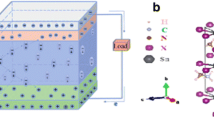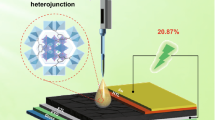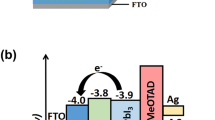Abstract
Cu-Ni bimetallic organic frameworks were synthesized by a facile and stepwise solvothermal method, utilizing metal organic framework as precursor. Core-shell CuO@NiO nanospheres were obtained by calcining the bimetallic organic frameworks at 400° C in the air atmosphere. NiO nanospheres were also prepared by calcining the Ni-BTC nanoparticles in the same conditions. Core-shell CuO@NiO and NiO nanoparticles synthesized by this procedure were employed in fabrication of perovskite solar cells (PSCs) as hole transport layer (HTL). In comparison with the performance of the NiO HTL–based PSC, device with core-shell CuO@NiO HTL exhibited a greater photon conversion efficiency 10.11% with a current density of 21.80 mA cm−2, an open-circuit voltage of 0.91 V, and a fill factor of 0.51, which is about 15% higher than that of the PSC with NiO HTL (8.58%). The excellent performance of PSC based on core-shell CuO@NiO HTL is mainly attributed to the high extraction of charge carrier due to favorable energy level alignment between perovskite and hole transport layer, increase in HTL conductivity, and decrease of defect density in the surface and bulk of HTL. The stability test of devices showed outstanding long-term stability for the inorganic HTL-based PSCs. The devices with NiO and CuO@NiO HTLs maintained more than 52% and 60% of their original efficiency after 1920 h (80 days), respectively. In contrast, the cell with spiro-OMeTAD retained only 31.74% of its initial efficiency under the same storage conditions after 1248 h (52 days).














Similar content being viewed by others
References
Xu L, Chen X, Jin J, Liu W, Dong B, Xue B, Song H, Reiss P (2019) Inverted perovskite solar cells employing doped NiO hole transport layers: a review. Nano Energy 63:103860
Jeon T, Kim SJ, Yoon J, Byun J, Hong HR, Lee TW (2017) Hybrid perovskites: effective crystal growth for optoelectronic applications. Adv Energy Mater 7(19):1602596
Liu W, Ma Z, Wang S, Jiang J, Yuan N, Ding J (2018) Low-temperature bromide modification of SnO2 for highly efficient perovskite solar cells. J Solid State Electerochem 22(12):3751–3759
Calio L, Kazim S, Grätzel M, Ahmad S (2016) Hole-transport materials for perovskite solar cells. Angew Chem Int Ed 55(47):14522–14545
Rajeswari R, Mrinalini M, Prasanthkumar S, Giribabu L (2017) Emerging of inorganic hole transporting materials for perovskite solar cells. Chem Rec 17(7):681–699
Yu Z, Sun L (2018) Inorganic hole-transporting materials for perovskite solar cells. Small Methods 2(2):1700280
Guo Y, Lei H, Xiong L, Li B, Fang G (2018) An integrated organic–inorganic hole transport layer for efficient and stable perovskite solar cells. J Mater Chem A 6(5):2157–2165
Mutalib MA, Aziz F, Ismail AF, Salleh WN, Yusof N, Jaafar J, Ludin NA (2018) Towards high performance perovskite solar cells: a review of morphological control and HTM development. Appl Mater Today 13:69–82
Schloemer TH, Christians JA, Luther JM, Sellinger A (2019) Doping strategies for small molecule organic hole-transport materials: impacts on perovskite solar cell performance and stability. Chem Sci 10(7):1904–1935
Lee JH, Noh YW, Jin IS, Park SH, Jung JW (2019) A facile surface engineering of nickel oxide thin film for enhanced power conversion efficiency of planar heterojunction perovskite solar cells. ACS Sustain Chem Eng 7(18):15495–15503
Ciro J, Ramírez D, Mejía Escobar MA, Montoya JF, Mesa S, Betancur R, Jaramillo F (2017) Self-functionalization behind a solution-processed NiOx film used as hole transporting layer for efficient perovskite solar cells. ACS Appl Mater Interfaces 9(14):12348–12354
Elseman AM, Sajid S, Shalan AE, Mohamed SA, Rashad M (2019) Recent progress concerning inorganic hole transport layers for efficient perovskite solar cells. Appl Phys A Mater Sci Process 125(7):476
Er U, Icli KC, Ozenbas M (2019) Spin-coated copper (I) thiocyanate as a hole transport layer for perovskite solar cells. J Solid State Electrochem 24(2):293–304. https://doi.org/10.1007/s10008-019-04430-2
Yin X, Guo Y, Xie H, Que W, Kong LB (2019) Nickel oxide as efficient hole transport materials for perovskite solar cells. Sol RRL 3(5):1900001
Shin SS, Lee SJ, Seok SI (2019) Metal oxide charge transport layers for efficient and stable perovskite solar cells. Adv Funct Mater 29(47):1900455. https://doi.org/10.1002/adfm.201900455
You J, Meng L, Song TB, Guo TF, Yang YM, Chang WH, Chen Q (2016) Improved air stability of perovskite solar cells via solution-processed metal oxide transport layers. Nat Nanotechnol 11(1):75–81
Zhu Z, Bai Y, Zhang T, Liu Z, Long X, Wei Z, Yan F (2014) High-performance hole-extraction layer of sol–gel-processed NiO nanocrystals for inverted planar perovskite solar cells. Angew Chem Int Ed 126(46):12779–12783
Kim JH, Liang PW, Williams ST, Cho N, Chueh CC, Glaz MS, Jen AKY (2015) High-performance and environmentally stable planar heterojunction perovskite solar cells based on a solution-processed copper-doped nickel oxide hole-transporting layer. Adv Mater 27(4):695–701
Dunlap Shohl WA, Daunis TB, Wang X, Wang J, Zhang B, Barrera D, Mitzi DB (2018) Room-temperature fabrication of a delafossite CuCrO2 hole transport layer for perovskite solar cells. J Mater Chem A 6(2):469–477
Garg A, Rao R (2018) Copper delafossites under high pressure- a brief review of XRD and raman spectroscopic studies. Crystals 8(6):255
Zhang H, Wang H, Chen W, Jen AKY (2017) CuGaO2: A Promising inorganic hole-transporting material for highly efficient and stable perovskite solar cells. Adv Mater 29(8):1604984
Vinogradov AV, Zaake-Hertling H, Hey-Hawkins E, Agafonov AV, Seisenbaeva GA, Kessler VG, Vinogradov VV (2014) The first depleted heterojunction TiO2-MOF-based solar cell. Chem Commun 50(71):10210–10213
Ryu U, Jee S, Park JS, Han IK, Lee JH, Park M, Choi KM (2018) Nanocrystalline titanium metal-organic frameworks for highly efficient and flexible perovskite solar cells. ACS Nano 12(5):4968–4975
Shen D, Pang A, Li Y, Dou J, Wei M (2018) Metal–organic frameworks at interfaces of hybrid perovskite solar cells for enhanced photovoltaic properties. Chem Commun 54(10):1253–1256
Corani A, Li MH, Shen PS, Chen P, Guo TF, Nahhas A, Zheng KB, Yartsev A, Sundstrom V, Ponseca CS (2016) Ultrafast dynamics of hole injection and recombination in organometal halide perovskite using nickel oxide as p-type contact electrode. J Phys Chem Lett 7(7):1096–1101
Tan R, Wei Z, Liang J, Lv Z, Chen B, Qu J, Ma J (2019) Enhanced open-circuit photovoltage and charge collection realized in pearl-like NiO/CuO composite nanowires based p-type dye sensitized solar cells. Mater Res Bull 116:131–136
Liu P, Wang C, Zhou D, Yuan Q, Wang Y, Hu Y, Feng L (2018) WOx@ PEDOT core–shell nanorods: hybrid hole-transporting materials for efficient and stable perovskite solar cells. ACS Appl Energy Mater 1(4):1742–1752
Ananthajothi P, Venkatachalam P (2016) Tin chloride perovskite-sensitized core/shell photoanode solar cell with spiro-MeOTAD hole transport material for enhanced solar light harvesting. J Solid State Electrochem 20(10):2633–2642
Long L, Liu X, Chen L, Li D, Jia J (2019) A hollow CuOx/NiOy nanocomposite for amperometric and non-enzymatic sensing of glucose and hydrogen peroxide. Microchim Acta 186(2):74
Guo W, Sun W, Wang Y (2015) Multilayer CuO@ NiO hollow spheres: microwave-assisted metal-organic-framework derivation and highly reversible structure-matched stepwise lithium storage. ACS Nano 9(11):11462–11471
Wu MK, Chen C, Zhou JJ, Yi FY, Tao K, Han L (2018) MOF–derived hollow double–shelled NiO nanospheres for high–performance supercapacitors. J Alloys Compd 734:1–8
Mohammadijoo M, Khorshidi ZN, Sadrnezhaad S, Mazinani V (2014) Synthesis and characterization of nickel oxide nanoparticle with wide band gap energy prepared via thermochemical processing. J Nanosci Nanothechnol 4(1):6–9
Kayani ZN, Butt MZ, Riaz S, Naseem S (2018) Synthesis of NiO nanoparticles by sol-gel technique. Mater Sci Pol 36(4):547–552. https://doi.org/10.2478/msp-2018-0088
Foster S, John S (2016) Light-trapping design for thin-film silicon-perovskite tandem solar cells. J Appl Phys 120(10):103103
Chu L, Liu W, Qin Z, Zhang R, Hu R, Yang J, Xa L (2018) Boosting efficiency of hole conductor-free perovskite solar cells by incorporating p-type NiO nanoparticles into carbon electrodes. Sol Energy Mater Sol C 178:164–169
Al-Ghamdi AA, Abdel-wahab MS, Farghali A, Hasan P (2016) Structural, optical and photo-catalytic activity of nanocrystalline NiO thin films. Mater Res Bull 75:71–77
Bayal N, Jeevanandam P (2012) Synthesis of CuO@ NiO core-shell nanoparticles by homogeneous precipitation method. J Alloys Compd 537:232–241
Liu Y, Song J, Qin Y, Qiu Q, Zhao Y, Zhu L, Qiang Y (2019) Cu-doped nickel oxide hole transporting layer via efficient low-temperature spraying combustion method for perovskite solar cells. J Mater Sci Mater Electron 30(16):15627–15635
Xu H, Zhang J, Rehman A, Gong L, Kan K, Li L, Shi K (2017) Synthesis of NiO@ CuO nanocomposite as high-performance gas sensing material for NO2 at room temperature. Appl Surf Sci 412:230–237
Moghe S, Acharya A, Panda R, Shrivastava S, Gangrade M, Shripathi T, Ganesan V (2012) Effect of copper doping on the change in the optical absorption behaviour in NiO thin films. Renew Energy 46:43–48
Tauc J, Grigorovici R, Vancu A (1966) Optical properties and electronic structure of amorphous germanium. Phys Status Solidi B 15(2):627–637
Hosny NM (2011) Synthesis, characterization and optical band gap of NiO nanoparticles derived from anthranilic acid precursors via a thermal decomposition route. Polyhedron 30(3):470–476
Gibbs ZM, LaLonde A, Snyder GJ (2013) Optical band gap and the Burstein–Moss effect in iodine doped PbTe using diffuse reflectance infrared Fourier transform spectroscopy. New J Phys 15(7):075020
Wang X, Song J, Gao L, Jin J, Zheng H, Zhang Z (2004) Optical and electrochemical properties of nanosized NiO via thermal decomposition of nickel oxalate nanofibres. Nanotechnology 16(1):37
Mallick P, Sahoo C (2013) Effect of CuO addition on the structural and optical properties of NiO nanoparticles. J Nanosci Nanotechnol 3(3):52–55
Gandhi A, Wu S (2017) Strong deep-level-emission photoluminescence in NiO nanoparticles. J Nanomater 7(8):231
Zhang J, Zeng D, Zhu Q, Wu J, Huang Q, Xie C (2016) Effect of nickel vacancies on the room-temperature NO2 sensing properties of mesoporous NiO nanosheets. J Phys Chem C 120(7):3936–3945
Ezhilarasi AA, Vijaya JJ, Kaviyarasu K, Maaza M, Ayeshamariam A, Kennedy LJ (2016) Green synthesis of NiO nanoparticles using Moringa oleifera extract and their biomedical applications: cytotoxicity effect of nanoparticles against HT-29 cancer cells. J Photochem Photobiol B 164:352–360
Siddique MN, Ahmed A, Ali T, Tripathi P (2018) Investigation of optical properties of nickel oxide nanostructures using photoluminescence and diffuse reflectance spectroscopy. Paper presented at the AIP Conference Proceedings. https://doi.org/10.1063/1.5032362
Mabrouk S, Bahram B, Gurung A, Reza KM, Adhikari N, Dubey A, Pathak R, Yang S, Qiao Q (2017) Higher efficiency perovskite solar cells using additives of LiI, LiTFSI and BMImI in the PbI2 precursor. Sustain Energy Fuels 1(10):2162–2171
Luo W, Wu C, Wang D, Zhang Z, Qi X, Guo X, Qu B, Xiao L, Chen Z (2019) Dopant-free Spiro-OMeTAD as hole transporting layer for stable and efficient perovskite solar cells. Org Electron 74:7–12
Sepalage GA, Meyer S, Pascoe AR, Scully AD, Bach U, Cheng YB, Spiccia L (2017) A facile deposition method for CuSCN: exploring the influence of CuSCN on JV hysteresis in planar perovskite solar cells. Nano Energy 32:310–319
Chavan RD, Yadav P, Nimbalkar A, Bhoite SP, Bhosale PN, Hong CK (2019) Ruthenium doped mesoporous titanium dioxide for highly efficient, hysteresis-free and stable perovskite solar cells. Sol Energy 186:156–165
Liu Z, Bi S, Gl H, Cz Y, Xj S (2019) Dual-sized TiO2 nanoparticles as scaffold layers in carbon-based mesoscopic perovskite solar cells with enhanced performance. J Power Sources 430:12–19
Han J, Tu Y, Liu Z, Liu X, Ye H, Tang Z, Liao G (2018) Efficient and stable inverted planar perovskite solar cells using dopant-free CuPc as hole transport layer. Electrochim Acta 273:273–281
Yamada Y, Yamada T, Shimazaki A, Wakamiya A, Kanemitsu Y (2016) Interfacial charge-carrier trapping in CH3NH3PbI3-based heterolayered structures revealed by time-resolved photoluminescence spectroscopy. J Phys Chem Lett 7(11):1972–1977
Basith NM, Vijaya JJ, Kennedy LJ, Bououdina M (2014) Structural, morphological, optical, and magnetic properties of Ni-doped CuO nanostructures prepared by a rapid microwave combustion method. Mater Sci Semicond Process 17:110–118
Han F, Luo J, Malik HA, Zhao B, Wan Z, Jia C (2017) A functional sulfonic additive for high efficiency and low hysteresis perovskite solar cells. J Power Sources 359:577–584
Luo J, Jia C, Wan Z, Han F, Zhao B, Wang R (2017) The novel dopant for hole-transporting material opens a new processing route to efficiently reduce hysteresis and improve stability of planar perovskite solar cells. J Power Sources 342:886–895
Li B, Li Y, Zheng C, Gao D, Huang W (2016) Advancements in the stability of perovskite solar cells: degradation mechanisms and improvement approaches. RSC Adv 6(44):38079–38091
Pitchaiya S, Natarajan M, Santhanam A, Asokan V, Yuvapragasam A, Ramakrishnan MV, Palanisamy SE, Sundaram S, Velauthapillai D (2020) A review on the classification of organic/inorganic/carbonaceous hole transporting materials for perovskite solar cell application. Arab J Chem 13(1):2526–2557
Kwon H, Lim JW, Han J, Quan LN, Kim D, Shin ES, Kim E, Kim DW, Noh YY, Chung I, Kim DH (2019) Towards efficient and stable perovskite solar cells employing non-hygroscopic F4-TCNQ doped TFB as the hole-transporting material. Nanoscale 11(41):19586–19594
Li W, Dong H, Wang L, Li N, Guo X, Li J, Qiu Y (2014) Montmorillonite as bifunctional buffer layer material for hybrid perovskite solar cells with protection from corrosion and retarding recombination. J Mater Chem A 2(33):13587–13592
Author information
Authors and Affiliations
Corresponding author
Ethics declarations
Conflict of interest
The authors declare that they have no conflict of interest.
Additional information
Publisher’s note
Springer Nature remains neutral with regard to jurisdictional claims in published maps and institutional affiliations.
Electronic supplementary material
ESM 1
(DOCX 423 kb)
Rights and permissions
About this article
Cite this article
Hazeghi, F., Mozaffari, S. & Ghorashi, S.M.B. Metal organic framework–derived core-shell CuO@NiO nanosphares as hole transport material in perovskite solar cell. J Solid State Electrochem 24, 1427–1438 (2020). https://doi.org/10.1007/s10008-020-04643-w
Received:
Revised:
Accepted:
Published:
Issue Date:
DOI: https://doi.org/10.1007/s10008-020-04643-w




